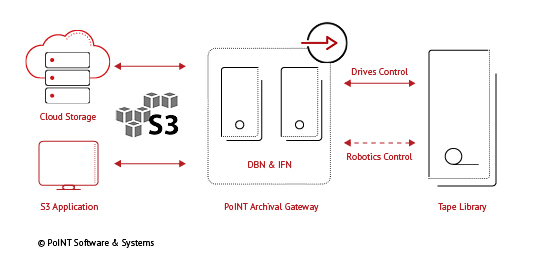The growth of unstructured data is one of the major challenges for enterprise IT departments. The enormous volumes of data require more storage capacity year after year. The infrastructure requirements are very high:
- The storage solution must meet high demands when it comes to performance and availability.
- Tight budget constraints have to be met.
Hybrid infrastructures combining different storage technologies enable efficiency gains. In this way, performance and capacity requirements are met. According to the respective needs of the company, combinations of different storage media (flash, disk, tape) with different interfaces (NVMe, SAS, SATA, iSCSI, FC) and methods (block, file, object) can provide an optimal solution to secure the large amounts of data.
In the object storage sector typically large hard disks are used. Hard disk-based object storage systems offer a flexible solution:
- large capacities,
- good scalability,
- standardized S3 interface,
- distributed infrastructure with HTTP protocol.
However, as data volumes continue to grow, the search for more affordable storage solutions begins.
The storage medium tape offers the lowest price per TB, as well as other economic advantages:
- The standardization of the technology and the LTO roadmap offer future security and investment protection.
- Tape libraries are highly scalable.
- The energy and power costs associated with operation are low compared to other storage technologies.
- The tapes offer a lifespan of up to 30 years.
Tape libraries are usually integrated via a Fibre Channel connection. This means that they are tied to one location and usually to one application and one use case. Therefore, tape offers many advantages, especially for large data volumes. However, these advantages can only be used to a limited extent when, for example, tape libraries are to be used for distributed infrastructures, cloud applications and data transfer via HTTP.
An S3 interface for tape libraries would significantly expand the scope of tape and make the advantages of tape technology available to many applications.
This is achieved by a software layer that receives the data via S3 and then writes it directly to tape. The data transfer via S3 is independent of the actual physical connection of the library. This means that any S3-capable application can use the tape library as a target storage device – regardless of its location.
One such software solution is the tape-based object storage PoINT Archival Gateway, which allows the integration of tape as S3 storage class. PoINT Archival Gateway receives data via the standardized S3 REST API and writes it directly to tape.

Using modern erasure coding techniques, the data is redundantly and simultaneously written to multiple tapes. This increases data security because the failure of a storage medium does not lead to the loss of the data. Furthermore, the simultaneous writing to several tapes increases the performance values.
With PoINT Archival Gateway tape libraries are provided as object storage. The advantages of tape technology can be used with this storage method. Since S3 is based on the HTTP/HTTPS protocol, S3‑capable applications can also use the libraries as target storage independent of their location.

